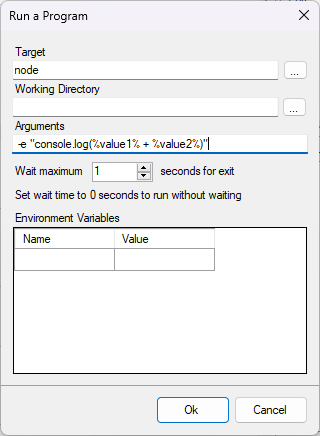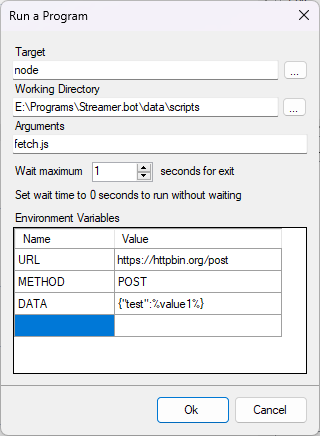Execute Scripts
You can utilize the Run a Program sub-action to execute scripts on the fly.
This can be great if you are more comfortable in another language, such as Python or Javascript, and less comfortable in C#.
Streamer.bot's built-in C# Code sub-actions are much more powerful, as a first-class integration, but you can still do a lot with some quick scripts in other languages!
Be;pw, we are going to showcase some basic ways you can use this functionality.
Basic Math
With node you can quickly evaluate inline scripts using node -e
Similarly, in python you can use python -c
In this example, we are going to use node to do a basic addition of two Streamer.bot variables
Add a Test trigger
%value1% and %value2%:

Configure your sub-action

- Target:
node - Arguments:
-e "console.log(%value1% + %value2%)" - Wait:
1
Wait parameter to a value greater than zero in order to get output from scriptsRun the action
Read Output
Action Queues > Action History and inspect the variables for the action execution, you will see output# variables were populated from the executed script.%output0%!HTTP POST Requests
Streamer.bot ships with a Fetch URL sub-action, but it can only send GET requests.
In this example, we will use node to send POST requests with variable data.
Create your script
fetch.js, inside the <YOUR_STREAMERBOT_DIR>/data/scripts directory.If you don't already have a scripts directory, feel free to create it place your scripts whereever you'd like!const url = process.env.URL;
fetch(url, {
// Default to GET, override if provided in environment variables
method: process.env.METHOD || 'GET',
headers: {
// Default to applicaton/json, override if provided in environment variables
'Content-Type': process.env.CONTENT_TYPE || 'application/json',
},
body: process.env.DATA,
}).then(response => {
// Send the response status code to %output0%
console.log(response.status);
// Send the response body to %output1%
// If the response is not JSON, you can use .text() instead of .json()
// We are just making sure we un-prettyify the JSON response to place it on a single line of output
response.json().then(data => console.log(JSON.stringify(data)));
});
Configure your sub-action

- Target:
node - Working Directory:
<path/to/your/scripts/directory> - Arguments:
fetch.js - Wait:
1 - Environment Variables:
This is where we will pass any data, including variables, to our script.Name Value Description URLhttps://httpbin.org/postExample URL, useful for testing METHODPOSTSend a HTTP POST request DATA{ "test": %value1% }Example JSON data containing variables
Run the action
Read Output
Action Queues > Action History and inspect the variables for the action execution, you will see output# variables were populated from the executed script.200 be available in %output0%
Any response data, in this case a JSON string, will be available in %output1%Discord Webhook Embeds
By extending the HTTP POST request example, you can create custom Discord Webhooks with your own embeds.
Create your script
const data = {
"embeds": [
{
"title": "Hello, world!",
"description": "This is an embed, sent from Streamer.bot, via a NodeJS sub-action!",
"color": 36863,
"fields": [
{
"name": process.env.FIELD_1_NAME,
"value": process.env.FIELD_1_VALUE,
},
{
"name": process.env.FIELD_2_NAME,
"value": process.env.FIELD_2_VALUE,
}
],
"author": {
"name": "Streamer.bot",
"url": "https://streamer.bot",
"icon_url": "https://streamer.bot/logo-transparent.png"
}
}
],
};
const url = process.env.WEBHOOK_URL;
fetch(url, {
method: 'POST',
headers: {
'Content-Type': 'application/json',
},
body: JSON.stringify(data),
}).then(response => {
// Send the response status code to %output0%
console.log(response.status);
});
Configure your sub-action

- Target:
node - Working Directory:
<path/to/your/scripts/directory> - Arguments:
fetch.js - Wait:
1 - Environment Variables:
This is where we will pass any data, including variables, to our script.Name Value Description FIELD_1_NAMEvalue1Label for embed field 1 FIELD_1_VALUE%value1%Value of embed field 1, loaded from variable FIELD_2_NAMEvalue2Label for embed field 2 FIELD_2_VALUE%value2%Value of embed field 2, loaded from variable WEBHOOK_URL<secret webhook url>Find in Discord channel settings -> Integrations
Run the action
Read Output
Action Queues > Action History and inspect the variables for the action execution, you will see output# variables were populated from the executed script.204 be available in %output0%